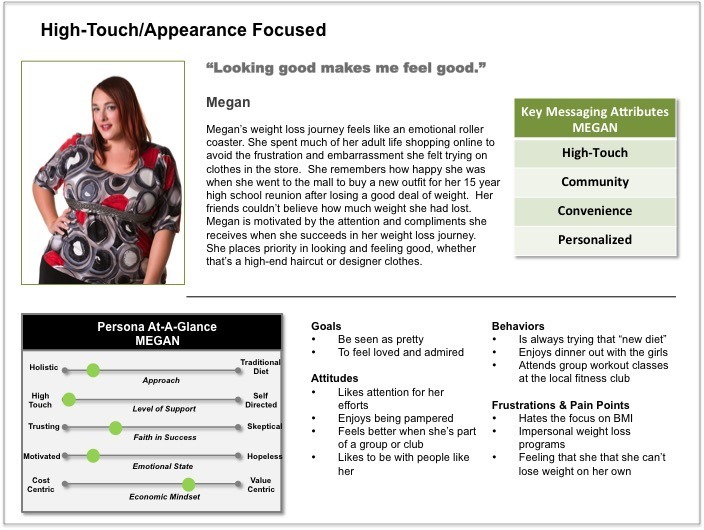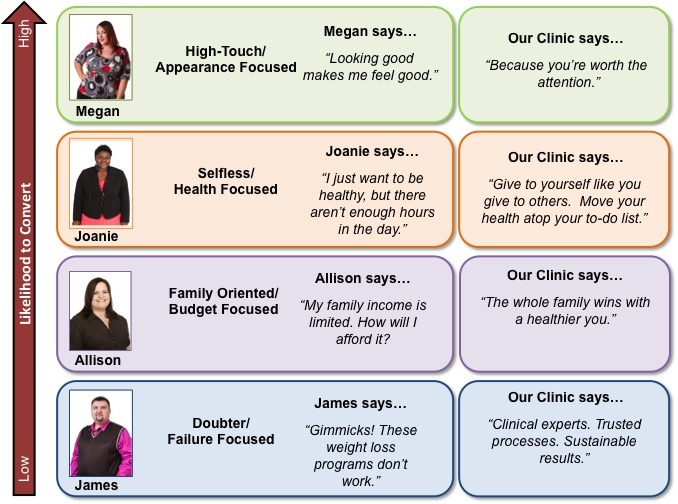How to Find Value in Personas for Health Care Marketing
From Research to Personas in 3 Steps
// By Matt Hummel //
 A recent Accenture report found a significant correlation between superior patient experiences and higher margins for hospitals of every type and size. In an increasingly choice-driven health care industry, it’s no wonder that “patient-centricity” is a buzzing topic for a variety of stakeholders—from regulators and payers to provider organizations.
A recent Accenture report found a significant correlation between superior patient experiences and higher margins for hospitals of every type and size. In an increasingly choice-driven health care industry, it’s no wonder that “patient-centricity” is a buzzing topic for a variety of stakeholders—from regulators and payers to provider organizations.
While there is no universally accepted definition, at its core and as the name suggests, patient-centricity is about putting the patient at the center of every product or service design. But to truly design a patient or customer-centric experience—one that is empathetic and authentic—it’s critical to get a complete, 360-degree understanding of customers (whether patients, providers, or caregivers) as people with real needs, concerns, and feelings along their health care journey. Personas can help us achieve this goal.
What Purpose Does a Persona Serve in Health Care?
It’s been almost 20 years since software designer Alan Cooper introduced the concept of the user persona in his book The Inmates Are Running the Asylum: Why High Tech Products Drive Us Crazy and How to Restore the Sanity. Since then, personas have become an essential tool for software development and web design projects.
A user persona is a qualitative tool that creates a fictional character to serve as an archetype to guide design and development. Often based on quantitative and ethnographic research inputs, a user persona brings the abstract concept of a targeted audience to life.These brief profiles typically include demographic, psychographic, and technographic information, as well as personal narrative elements that create a comprehensive picture of the user’s behaviors, environment, desires, and needs.
Through personas, we get to know about why our customers behave in the way they do. It’s the why that’s really important—allowing us to segment in terms of value, attitudes, and behavior instead of just in terms of demographics. This is especially critical in health care, where user emotions can range from empowerment to frustration and even hopelessness. Once you discover how customers feel and what they truly value on key dimensions, you can craft personalized experiences that resonate emotionally and promote the ultimate feeling and experience desired (whether that’s convenience, care, or comfort, etc.). Great experiences, those that build engagement and loyalty, are ultimately measured by how you make someone feel.
How to Avoid Stereotyping Consumers
Personas also help marketers avoid the trap of relying on their own perception (the “this is what I would want” bias), a broad stereotypical depiction of the consumer, or the view of the last person they actually talked to (mom, neighbor, focus group member) when making decisions. Instead, it is typical to create multiple personas per traditional segment (e.g., patients), enabling marketers to get a well-rounded, representative view of their customer base to make educated, thoughtful, and unbiased decisions that satisfy customer needs.
From Research to Personas in 3 Steps
Step 1: Talk to real people
The best personas are built based on a series of one-on-one interviews with key consumer segments (patients, researchers, students, providers, caregivers). In general, it can take as little as 6 to 12 interviews to begin to see patterns in the data that help to form persona types. These interviews are best performed in context, as often you’ll find that people react differently in groups (focus groups) versus a 1:1 engagement. For example, we’ve found that patient intercepts conducted in a waiting room are a valuable tool—mostly because you’re talking to real patients, in the real context of being a patient. Even informal research conducted in a waiting room with real patients will yield deeper insights than using internal stakeholders as patient proxies.
Building strong personas is less about the demographics—for example, how old or wealthy a person is, and more about what they value and how they behave. For that reason, one persona type can actually span across demographics. Often, the researcher begins with a broad open-ended discussion that eventually focuses on an organization’s products or services. Below are a few key dimensions we often aim to tease out in our interviews:
- Values: What does he/she value in a health system and interactions across the care continuum?
- Goals and Motivations: What outcome does he/she look to achieve as a result of engaging with your organization, and what motivations drive him/her toward fulfilling that goal?
- Challenges and Pain Points: What pitfalls is he/she experiencing when interacting with the health system? How are they feeling during these pain points?
- Behaviors: What day-to-day behaviors impact his/her goals, motivation, and interactions with the organization (e.g., using a their phone to manage health needs due to a busy schedule).
- Attitudes and Feelings: What does he/she “feel” when seeking care (scared, frustrated, empowered)? How is that feeling impacted at certain touchpoints?
Don’t feel constrained to follow persona best practices used in software and product development. Consider including communication-specific attributes like media usage and previous brand exposure to make the persona work for your specific project.
Step 2: Find the commonalities
The next step is to analyze the series of interviews to derive commonalities. Each participant is first grouped based on role (physician, patient, researcher, caregiver), and then participants are ranked along an attribute scale for each dimension that was discussed, searching for values, attitudes, and behaviors that are common. As patterns and trends start to develop, groups of participants with common traits become the foundation for each persona type.
You can categorize participants into personas as broadly or as narrowly as you want. But finding the right balance is important so that your personas can adequately reflect your customer segments and can be most useful to reference when making business and marketing decisions.
Step 3: Write the brief persona profile
This profile is a fictional story to understand and empathize with what your customers experience. The nomenclature, or parts of a persona, may vary based on the team creating it, but generally consist of a persona name (that describes the persona); fictional name; basic demographics such as age, education, ethnicity, and family status; a quote that summarizes key feelings; a photograph; a summary of the person and his/her day-to-day life; and key points as they relate to the dimensions studied in the research. The goal is to create a real-life snapshot that employees and key stakeholders can relate to.
Here is an example of a persona we created at Red Privet:
Now We Have Our Persona. What Can It Be Used For?
Personas have many applications, and when used correctly, they can get your organization a big bang for the buck. Too often, personas are developed and filed away in a market research folder. Instead, your cross-functional project or department teams should readily and regularly access them as a reference to ensure you’re getting the customer at the center of your marketing message or design project. When your product, service, or operational design teams discuss whether or not an approach will work for the personas, you know you’re building a customer-first culture.
Here are a few tactical applications for organizational teams:
- Designing products or services: By helping to keep “real people” in mind when designing experiences—waiting-room design, mobile apps, websites, call centers, in-office experience, a stay in the hospital, etc. Employee teams should reference key personas to answer the question: “Will this solution work for Persona A? Persona B? Persona C?”
- Crafting personalized or segmented marketing messages: Understanding customer values makes it easier to create messages that resonate with them. Segmenting messages based on key persona groups can help increase loyalty.
- Building journey maps for customer experience improvements: Mapping out a persona’s journey with your brand can help to identify and solve for key pain points and improve the overall service experience.
- Prioritizing business and marketing decisions: Prioritizing product roadmaps based on the needs and desires that will yield the most positive impact for your key persona groups.
Personas in Practice: Segmenting Marketing Messages for a Weight Loss Clinic
We recently worked with a regional health system that was launching a new, physician-mediated weight loss center. The program offered a holistic approach to weight loss that included nutritional counseling, behavior modification, and a dedicated physician for each patient. While clinically superior to many weight loss options available in the market, the center was struggling to break through a cluttered consumer market flooded with big-budget, brand-name solutions like Weight Watchers, Jenny Craig, and Nutrisystem.
To better understand the mindset of the new clinic’s potential patients, we built personas based on ethnographic research. After meeting with prospective patients, we identified four user personas that represented four distinct mental models. After developing and analyzing these four personas, we could identify which personas represented the best opportunity to grow the new weight loss center’s market, while also seeing that a “one-size-fits-all” approach wouldn’t be effective in reaching all audiences. That led us to the development of sample marketing messages that illustrated the differences between the personas. For example, while one persona was driven by appearance concerns, others were more economically minded.
By using personas, we were able to humanize qualitative market segmentation data to develop messages that appealed to audiences based on deeply held core values and beliefs, resulting in a more impactful and successful campaign.
In Short
Simply put, all customers (whether patients, caregivers, researchers, or providers) are not the same. Making decisions based on one individual, or the last rant you read on your social media page, can be troublesome in the long run. Personas are a useful tool for condensing and synthesizing both quantitative and qualitative research to get an understanding of your customers as real people—and when used effectively, this insight can keep any project focused exactly where it needs to be: on the patients.
Matt Hummel knows that not every opportunity for customer engagement is the same. That’s why he founded Red Privet, a customer research, digital design, and experience strategy firm that creates meaningful engagement and delivers meaningful business results for leading companies, including Johns Hopkins Medicine, Highmark Blue Shield, and Geisinger Health System. He is Red Privet’s President.



